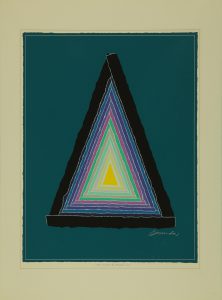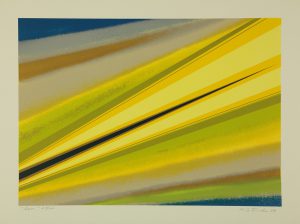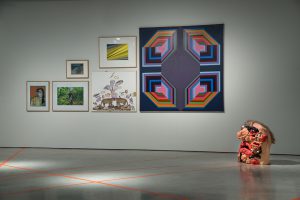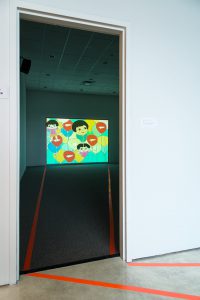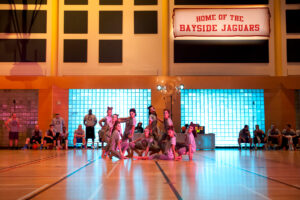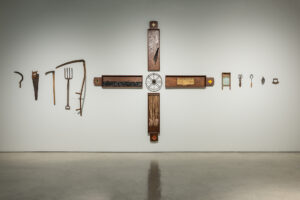With Abstract Random, Sonja Ahlers, Eleanor Bond, Allyson Clay, Erika DeFreitas, Servulo Esmeraldo, Andrew Harwood, Jesi The Elder, Hannah Jickling, Margaret Lawrence, Rita Letendre, Johnson Ngo, Bodo Pfeifer, Adee Roberson, Arthur Secunda, Fiona Smyth
What FAG is:
FAG is a response, a process, a site, a protest, an outcry, an exhibition platform, an economy, a framework, and an opportunity. We host, we fund, we advocate, we support and we claim. FAG is located in Toronto, Canada and is run by artists Allyson Mitchell and Deirdre Logue.
WE WON’T COMPETE is the second articulation of FAG’s Feminist Art Collection and is comprised of collected art works as well as materials and documentation from social sculptures and happenings at the FAG over the past four years.
WE CAN’T COMPETE/WE WON’T COMPETE
WE CAN’T KEEP UP/WE WON’T KEEP DOWN
These statements are an acknowledgement of the dilemmas of feminist and queer cultural participation and describe the all too familiar push/pull of working across discourses and converging dialogues.
At the Art Gallery of Windsor:
The opportunity offered through the Art Gallery of Windsor to exhibit works from their collection as well as ours provides us with the chance to test a new model within institutional parameters – to challenge and however temporarily change the system. We aim to create a collaborative exhibition that is inclusive, that recognizes artists at every stage in their careers, that offers opportunities for publication and remuneration, and that makes them visible within a public and social framework fulfilling FAG’s desire to make artists who are almost always invisible- visible.
The economies of art institutions and the powers that dominate the art world do not champion, or recognize artists working from the margins. It is this truth and injustice that prompted the creation of the Feminist Art Collection. FAC is as much an archive as it is an intervention into the economic hierarchies that fail to value feminist and queer artists (including artists of colour, women artists, Aboriginal artists, trans artists and artists with disabilitiy/ies).
What FAC is:
The Feminist Art Collection is a deterritorialized body of feminist art collected by FAG and through an interactional network of artists and enablers in support of queer and feminist cultural production. Art that enters into the FAC is bought from the artists and exists in the care of an enabler. Institutions (like the Art Gallery of Windsor) that borrow from the FAC enter into a declaration of participation, a social contract that acknowledges the value of the artwork and ensures the artist will be paid for the exhibition of the work. The FAC does not contain, possess, and capitalize on artists. As this young collection grows we struggle with the language for feminist description. How do we describe an object or image or sound piece as feminist and/or queer?
All of the art in this exhibition incorporates abstraction – of visual codes, of relationships and of bodies in relation to space. When we looked through the collection held by the Art Gallery of Windsor we discovered the same kind of obvious holes that most collections have. To speak plainly, there are very few pieces by artists of colour/feminist and or queer artists. But as feminist curatorial scholars have noted, art history is full of holes, fissures and absences. The way through this is to use absences as an opportunity to create a presence (we are borrowing heavily from Helen Molesworth’s theory of feminist curating). Maybe we can actually quote her here.
Need to connect the opportunity abstraction offers us to be representative/ to feel free of the didactic in order to use a responsive, intuitive, feeling model and to create a ‘community’of works
WE WON’T COMPETE. We aren’t going to fix what’s broken. Instead we bring work into the gallery that calls out to the collection, summons it forth and imagines a new. This strategy allows for a kind of utopic vision; using social networks, friendship, activism, provocation and queer family making, we create a queer/feminist collection of work from both absence and presence. We find ways for the work to touch, to relate, to repair.
This community of work stands up together – stronger and more visible as a collective consciousness than if they were to stand alone. In bringing the individual works into close proximity we create a resistant genealogy. We take out the hierarchy, the uniqueness of each and make the whole unique.
Molesworth, Helen. “How To Install Art As A Feminist” in Modern Women: Women Artists at the Museum of Modern Art, edited by Cornelia Butler and Alexandra Schwartz, MOMA publications, 2009.
Deirdre Logue and Allyson Mitchell
Read a review on AKIMBLOG by Kim Neudorf: http://www.akimbo.ca/akimblog/?id=903
